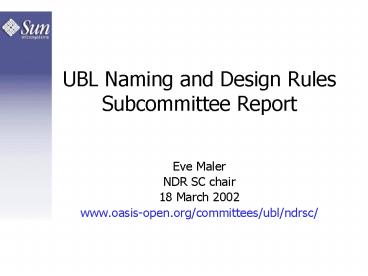UBL Naming and Design Rules Subcommittee Report PowerPoint PPT Presentation
Title: UBL Naming and Design Rules Subcommittee Report
1
UBL Naming and Design Rules Subcommittee Report
- Eve Maler
- NDR SC chair
- 18 March 2002
- www.oasis-open.org/committees/ubl/ndrsc/
2
What does the NDR SC do?
- Recommend to the TC rules and guidelines for
normative-form schema design, instance design,
and markup naming, and write and maintain
documentation of these rules and guidelines
(were the XML geeks) - SC members champion issues by writing position
papers - Eventually, the NDR document will hold all our
recommendations
3
Current NDR SC members
- Bill Burcham
- Mavis Cournane
- Mark Crawford (editor, vice-chair)
- Fabrice Desré
- John Dumay
- Matt Gertner
- Phil Griffin
- Arofan Gregory
- Eduardo Gutentag
- Eve Maler (chair)
- Dale McKay
- Joe Moeller
- Sue Probert
- Ron Schuldt
- Lisa Seaburg
- Gunther Stuhec
- Paul Thorpe
- (thanks to all these folks for their hard work!)
4
Status 16 Mar 02 distribution
- The following papers are nearing completion, and
drafts are available for review now - Modularity, namespaces, and versioning
(modnamver) plus example code V03 - Defining and naming elements, attributes, and
types (tag structure) V03 - Choosing elements vs. attributes V03
- Defining code lists V04
- See the ubl or ubl-comment mail archives as of 17
Mar, or see me this week to borrow a diskette
with a zip file
5
First two recommendations, done a while back
- Schema language
- The normative source format for schema files will
be W3C XML Schema (XSD), though we may not
directly author in this - Other formats may be generated
- Legal issues
- We sought advice on whether default values are a
legal problem (as theyre absent from the
instance but still part of the data) - Conclusion implied terms have been acceptable
for a long time
6
Modnamver progress nam
- One namespace for the core library
- One namespace per root schema
- Where a root schema defines all types and message
root elements for one functional area - Possibility of intermediate namespaces (and thus
roots) as we go along - Likely for loading/performance reasons
- Investigating URNs as namespace names
- UBL extensions made by others must define their
own namespaces - Which are encouraged to be keyed to contexts
7
Modnamver progress mod
- Encourage creation of new instance roots
(individual message root elements) even for
slightly different document forms - Root schema for instance root may include several
schema modules, and will import core root schema - If intermediate levels get added, more roots will
be imported at the various levels - How to handle borrowing across functional
areas? - Core root schema will probably have an artificial
root element - For developer convenience
8
Sample modules
9
Modnamver progress ver
- Versions are associated with namespaces, not with
individual modules - We are considering a Major.Minor version number
structure - Based on backwards compatibility of the change
- Not sure how to encode the versions yet
- Current common practice attribute on root
element, in namespace URI, in filename - An idea incorporate into the context
methodology? - Not sure of relationship between core and
functional namespace versions yet
10
Tag structure progress
- Makes use of ISO 11179 concepts and their
realization in ebXML CC - Object class and property especially
- XML allows us to reuse types, and thus most names
of types and elements will be generic - The dictionary will spell out the semantics for
the fully qualified path for each element and
attribute - This locks down a particular object
class/property and other details, so that there
is zero semantic ambiguity
11
More tag structure detail
- Top-level elements are global, and non-top-level
elements are local/unqualified - On intermediate elements, Details is the RT and
is thus left off the name - On leaf elements and attributes, RTs generally
appear on names - Text is the default and is thus left off
- ID is the required shorthand for Identifier
- We may need to add XML-specific RTs, e.g. for
mixed content
12
Elements vs. attributes
- Main component content should be elements
- Aggregates will break down into subelements,
often using container elements - Order and cardinality are important
- Empty elements thus not needed
- Supplementary components should be attributes
- E.g., for currency codes on amounts
- They tend to be unordered
- Free extension is generally not a desired option
- Common attributes proposed
- uid, uidRefs, language
13
Code lists
- Design principles semantic clarity, management
of maintenance costs, validation, subsetting,
and extension - Code list choices and usage must be documented
- Codes supplied as XSD QNames
- Code list namespace prefix and actual code
- Very extensible while providing clear semantics
- But pushes most validation to the application
level
14
Additional work in progress
- Roles of elements and attributes relative to a
type and the potential effect on naming (role
model) - Type hierarchies and abstract types (reoccurring
types) - Representing the original context of extracted
data when constructing UBL messages (native
context)
15
What we hope to accomplish this week
- Schema code review
- Reoccurring types
- Native context
- Role model
- Requirements around embedded documentation
- How do simple types relate to CCTs and RTs?
- Exit criteria for the NDR SC
- We would like to work more directly with (Tims)
LC SC in the future, including this week - New naming and design rules will ideally be much
more emergent
16
Please visit the NDR SC portal
- It always summarizes our status and provides
links to all papers, use cases, and additional
resourceswww.oasis-open.org/committees/ubl/ndrsc
/ - Updated approximately weekly
- And please review our position papers!
17
Thank you
- Eve Maler
- NDR SC chair
- 18 March 2002
- www.oasis-open.org/committees/ubl/ndrsc/

